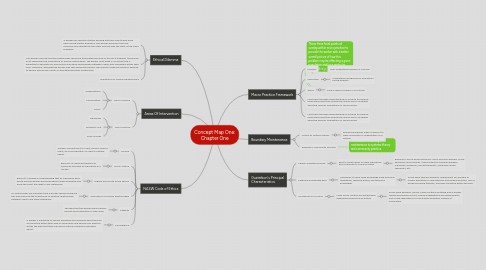
1. Ethical Dilemma
1.1. A worker has recently started working with two clients who have been facing marital problems. The worker discovers that one individual has cheated on the other and this was the start of the major problems.
1.2. The worker may feel that the relationship should be terminated because of this fact; however, the worker must remember the importance of human relationships. The worker must keep in mind that she is expected to advocate for and reinforce positive relationships between clients and individuals within their lives. Therefore, although the worker may feel differently herself, she needs to keep her personal feelings to herself and aid her clients in strengthening their relationship.
1.3. Importance of Human Relationships
2. Areas Of Intervention
2.1. Macro Practice
2.1.1. Organizations
2.1.2. Communities
2.1.3. Policy
2.2. Micro Practice
2.2.1. Individuals
2.2.2. Domestic Unit
2.2.3. Small Groups
3. Macro Practice Framework
3.1. Problem
3.1.1. Must understand problem of concern
3.2. Population
3.2.1. Understand background of population facing problem
3.3. Arena
3.3.1. Area in which problem is occurring.
3.4. Must have through understanding of all three to properly understand what the underlying causes are for problems affecting specific populations in various areas.
3.5. Must have through understanding of all three to properly understand what the underlying causes are for problems affecting specific populations in various areas.
4. Boundary Maintenance
4.1. Critical to systems theory
4.1.1. Blurred boundaries make it difficult to view community or organization as a system
4.2. Relevant in community practice
5. NASW Code of Ethics
5.1. Service
5.1.1. Workers commitment to client, holistic view of client, and consideration of client's multiple needs.
5.2. Social Justice
5.2.1. Refers to an equal distribution of resources amongst all individuals in a society.
5.3. Dignity and Worth of the Person
5.3.1. Refers to a worker's understanding that all individuals have worth and the worker should recognize these strengths and allow the client the right to self-determine.
5.4. Importance of Human Relationships
5.4.1. All relationships are important and a worker should recognize this and reinforce the importance of positive relationships between clients and other individuals.
5.5. Integrity
5.5.1. The idea that the worker should remain honest and trustworthy in their work,
5.6. Competence
5.6.1. A worker is expected to remain educated and informed about policies and practice within their area of social work and should only practice within the area that they are familiar with and properly educated about.
6. Gustafson's Principal Characteristics
6.1. People-oriented purpose
6.1.1. Exist to meet needs of other individuals and contribute to common good.
6.1.1.1. Example in social work profession: micro practice workers. Some examples could include: Child Protective Services workers, individual counselors, family therapists, substance abuse therapists, etc.
6.2. Extensive knowledge base
6.2.1. Necessary to have large knowledge base involving theoretical, research based, and technical knowledge.
6.2.1.1. Social work specific example; requirement for workers to remain educated on new theories surrounding practice, use of evidence-based theories, and direct practice within the field.
6.3. Mechanisms of control
6.3.1. Many social controls are established regarding professional activities.
6.3.1.1. Social work example: NASW Code of Ethics dictating how a worker should and should not act, licensing regulations and requirements, and CSWE regulations for social work programs offered at universities.
